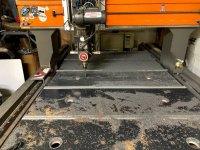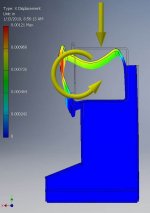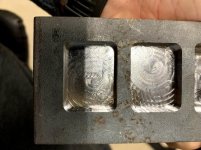Scott.Damman
Plastic
- Joined
- Jan 10, 2016
Looking for a little help on an ongoing project. I am adding a low speed spindle to my CNC router, specifically adding a Fadal spindle. Currently the machine has a 10hp 24,000 rpm BT30 spindle on it. I would like to also be able to cut steel with this machine. So the plan is to make the spindle swappable from the current spindle to lower speed spindle. I know that the machine will be very limited in capability on steel and I will need to take lite cuts and baby it. But I only have space for one machine so making it capable of both is key.
Some info on the machine it is a pretty hefty/robust machine as far as CNC routers go...
5ftx10ft machining area with 22inch on Z. All steel construction, stress relieved and all critical surfaces machined.
Ballscrew and servo motor driven
The bed is designed to be removable, in the photo below it has the vacuum table for wood hold down on it. This will be removed and a T slot table added along with coolant catching tray and side shields. The plan will be to start out with a small area (20"x40") of the actual table and build a partial enclosure around it in order to use coolant.
A couple of photos for reference and scale



So I have chosen to use Fadal parts because they are readily available and pretty inexpensive. I found a great deal on a 15hp spindle motor (way bigger than what I will ever be able to put to use but it was scrap price and came with pulleys, belt guide, and tensioner). I ran the motor in WYE configuration with a VFD I had seems to run very smooth. However it did pull nameplate current with no load so thinking I will have it checked at a motor shop. I will run this with a AMC vector drive and setup a WYE/Delta relay system. I purchased a used spindle which the seller says will need to be rebuilt at some point soon but my thought was it will get me going and I can rebuild it or have it rebuilt in the future.
Here's where my initial couple of questions come in.
Does anyone know the bore diameter in a Fadal Z axis casting for the spindle?
I have watched a few videos of people replacing the spindle and it seems to be a loose fit. Also the process for tramming the spindle is to add shims under the spindle bolt flange so assuming there is some clearance in the bore.
For the 2 speed system I assume the AMC drive does not "know" what speed range the pulleys are in. The control just asks for a motor speed (+ - 0-10v as well as the forward reverse inputs)and the AMC drive outputs to achieve that speed. Can anyone confirm this? I plan to set it up this way. I will likely have the speed range change done manually or make an additional Mach4 setup for the 2nd speed. Likely I will be running in low speed most of the time. Initially I may just manually tension the belt. I plan to make my motor mount setup slotted, since even if I want to use the idler pulley setup I may need some adjustment as I dont know Fadal spindle center line to motor center line. Should allow adjustment of the loose belt to allow proper slip.
Unless someone has the spindle center to motor center measurement?
Does anyone have any good thoughts on how to easily align these spindle with minimal setup adjustment time after swapping? I plan to rebuild the Z axis eventually to make things a little more robust (larger section). The current spindle has a 12mm slot milled on centerline to the spindle. So I could use something similar on the Fadal spindle mount bracket but wondering if there is something better.
Thoughts on drawbar knockout cylinder? I could buy the Fadal one but that is pretty pricey and machine scrappers seem to just throw that part away. I have a couple local scrappers that I have asked to keep an eye out for one. I will have the Fadal belt guide around the pulley so will have the same mounts. Other thoughts are welcome.
Thanks in advance for the help
Some info on the machine it is a pretty hefty/robust machine as far as CNC routers go...
5ftx10ft machining area with 22inch on Z. All steel construction, stress relieved and all critical surfaces machined.
Ballscrew and servo motor driven
The bed is designed to be removable, in the photo below it has the vacuum table for wood hold down on it. This will be removed and a T slot table added along with coolant catching tray and side shields. The plan will be to start out with a small area (20"x40") of the actual table and build a partial enclosure around it in order to use coolant.
A couple of photos for reference and scale



So I have chosen to use Fadal parts because they are readily available and pretty inexpensive. I found a great deal on a 15hp spindle motor (way bigger than what I will ever be able to put to use but it was scrap price and came with pulleys, belt guide, and tensioner). I ran the motor in WYE configuration with a VFD I had seems to run very smooth. However it did pull nameplate current with no load so thinking I will have it checked at a motor shop. I will run this with a AMC vector drive and setup a WYE/Delta relay system. I purchased a used spindle which the seller says will need to be rebuilt at some point soon but my thought was it will get me going and I can rebuild it or have it rebuilt in the future.
Here's where my initial couple of questions come in.
Does anyone know the bore diameter in a Fadal Z axis casting for the spindle?
I have watched a few videos of people replacing the spindle and it seems to be a loose fit. Also the process for tramming the spindle is to add shims under the spindle bolt flange so assuming there is some clearance in the bore.
For the 2 speed system I assume the AMC drive does not "know" what speed range the pulleys are in. The control just asks for a motor speed (+ - 0-10v as well as the forward reverse inputs)and the AMC drive outputs to achieve that speed. Can anyone confirm this? I plan to set it up this way. I will likely have the speed range change done manually or make an additional Mach4 setup for the 2nd speed. Likely I will be running in low speed most of the time. Initially I may just manually tension the belt. I plan to make my motor mount setup slotted, since even if I want to use the idler pulley setup I may need some adjustment as I dont know Fadal spindle center line to motor center line. Should allow adjustment of the loose belt to allow proper slip.
Unless someone has the spindle center to motor center measurement?
Does anyone have any good thoughts on how to easily align these spindle with minimal setup adjustment time after swapping? I plan to rebuild the Z axis eventually to make things a little more robust (larger section). The current spindle has a 12mm slot milled on centerline to the spindle. So I could use something similar on the Fadal spindle mount bracket but wondering if there is something better.
Thoughts on drawbar knockout cylinder? I could buy the Fadal one but that is pretty pricey and machine scrappers seem to just throw that part away. I have a couple local scrappers that I have asked to keep an eye out for one. I will have the Fadal belt guide around the pulley so will have the same mounts. Other thoughts are welcome.
Thanks in advance for the help















